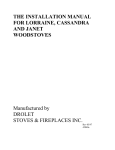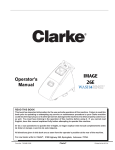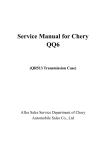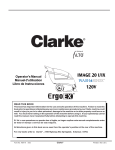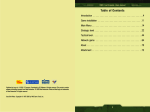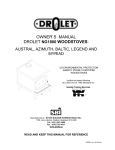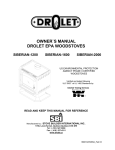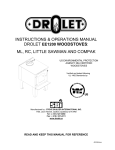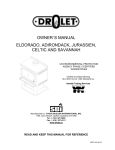Download Acquisitions X-FIRE 1200 Installation manual
Transcript
THE INSTALLATION MANUAL FOR GEMINI 1200 AND GEMINI 1500 WOODSTOVES Manufactured by DROLET STOVES & FIREPLACES INC. Rev 07/96 45041a ________________________________________________ THE INSTALLATION MANUAL FOR GEMINI 1200 ET GEMINI 1500 WOODSTOVES ________________________________________________ DROLET STOVES & FIREPLACES Inc. is pleased to congratulate you on your new acquisition. We would like to assist you in drawing the utmost benefit from the unit which you have selected. Therefore, we would like to offer a few useful hints on heating with wood and on controlled combustion in particular. Moreover, the technical data specifications pertaining to the model which you have chosen are outlined on the following pages, including instructions for installation, use and maintenance. The installation instructions in accordance with the standards set by ULC #S627, must be followed exactly in order to avoid the possibility of major problems. Your instruction booklet is a gold mine of information. Keep it handy. 1 ________________________________________________ INSTALLATION ________________________________________________ Your stove must be mounted on fireproof surface. If you have decided to mount it on an area where flooring material is not fireproof, then you must add a panel of asbestos between the stove and the floor. The thickness and dimensions of this panel differ according to each model, as outlined in the following chart. __________________________________________________________________________ Model Thickness Panel Panel Panel of Protrusion Protrusions Protrusion panel at front at sides at back __________________________________________________________________________ Gemini 1200 3/8" (7mm) 18" (457mm) 6" (150mm) 6" (150mm) __________________________________________________________________________ Gemini 1500 3/8" (7mm) 18" (457mm) 6" (150mm) 6" (150mm) __________________________________________________________________________ Note: Asbestos panel can be replaced by a ceramic of gauge 18 sheet metal. 1) Whether you choose to install your stove cornerwise in a room or parallel to a wall, you must adhere to the specifications for distances to be respected. These are clearly illustrated for each particular model. Gemini 1200..............................................................................................................drawing #1 Gemini 1500..............................................................................................................drawing #1 2) Note : Only competent authorities can approve shorter distances. 3) Avoid placing wood or other inflammable substances too close to your heating unit. As we have already stipulated, make sure that the proper distances are respected between your unit and any inflammable substances. 2 ______________________________________________________ SMOKE EVACUATION SYSTEM ________________________________________________ A good smoke evacuation system will ensure superior performance if you observe these precautionary measures: 1) The stove pipe and the chimney must be of the same dimension as the woodstove outlet, minimum height 15 feet from floor to chimney top. 2) If you use an insulated chimney, make sure that it has the necessary approvals. You must follow very closely the instructions given by the manufacturer. 3) If you choose to equip your stove with a masonry chimney, we strongly recommend that you call on specialist. Make sure that the masonry encasement of the clay tiles is 8 inches thick. This thickness is recommended so that the chimney can retain its heat, thereby preventing excessively rapid cooling of the gases, which, in turn, results in excessive creosote and soot formation. 4) Should a spark arrestor be required at the end of your chimney, it must be inspected at frequent intervals in order to prevent any accumulation of creosote and soot from blocking the chimney. 5) We recommend that you use a chimney connector pipe made of conventional steel of a minimum 24 gauge thickness. Read carefully your installation manual provided by the chimney manufacturer before proceeding to the installation. Check with your local building code before making a hole in a wall or ceiling for a chimney opening. 6) Your smoke outlet system should be completely airtight. In order to achieve this, assemble the pipe lengths in position, male end facing downwards. Each length should then be fixed in place with three metal screw per section, each one at an equal distance apart. (See illustration page 11). 7) The chimney pipe system should be straight and short. If a horizontal installation is unavoidable, you must allow a minimum slope of 1/4" per foot. 8) The stove should not be connected to a central heating unit. 3 ________________________________________________ ATTENTION ________________________________________________ • The smoke pipe should not run through an attic, roof space, wardrobe nor any other enclosure. It should not run through a wall, floor, ceiling nor be close to any inflammable room divider. • Never connect more than one heating unit per chimney. • Never use galvanized steel chimney pipe. The smoke fumes caused by excessive heat are toxic and zinc, in melting, could be harmful to the surroundings. • Have the chimney system inspected frequently and, if necessary, call on the services of chimney-sweep. • Failure to follow the preceeding recommendations could result in a chimney fire. • Make sure that all firebricks are well set in the device. ________________________________________________ IMPORTANT ________________________________________________ Do not forget to remove the plastic film covering the brass decorative trims of the stove before heating for the first time. 4 ________________________________________________ AIR CIRCULATION SYSTEM ________________________________________________ • Optional accessories for air circulating system. • Blower (100 CFM) c/w speed control. • This blower attach to the second wall which covers the back of your stove. This second wall acts as a heat exchanger. Air enters at the back, circulates between heat shield and the stove and is projected toward front when heated. ______________________________________________________ OPERATING INSTRUCTIONS ______________________________________________________ a) Only wood should be used as fuel. b) Drolet stoves are not designed for a wood cradle, nor do they provide support facilities for the wood. Therefore, never use grate or elevated fire. They would generate excessive temperature. c) When using your unit for the first time, to avoid thermic shocks do not heat your stove to the maximum. This causes the painted surface to deteriorate. Be sure that ventilation in the room is adequate. This will prevent any inconvenience arising from smoke and disagreeable odor given off by heated paint. d) Before lighting your stove, be sure that the air control is wide open. If you feel air currents coming from the chimney, slightly open a window close by and hold a lighted paper in the opening as close as possible to the flue outlet. This will heat air in the chimney. e) When the paper and dry wood have been lighted, keep the air control in position "Open" until you have obtained a good fire. From then on, you may add larger logs of wood until a bed of embers has built. It is recommend during pre-heat period to leave the door slightly open to ease combustion. f) We recommend the use of a magnetic thermometer on your stove pipe. It should be installed 18 inches above the stove top, to indicate the gas temperature. We also 5 recommend to adjust the air intake to maintain the gas temperature always above 300o F. g) Before you open doors to reload or check level of combustion, open the air control to permit gases and smoke to leave. h) We suggest you to try to maintain a bed of embers approximately one inch thick to ensure uniformity of combustion. i) Under no consideration should you modify or alter the operation of air entries. j) Modern homes are better insulated and tightly constructed. These advantages often cause certain inconveniences. It is common for air leaving by the chimney or vent on the cooking stove not to be replaced; the house, then, is in a low or negative pressure situation. Should this happen, you should install an outside air duct with adjustable opening as close as possible to the controls of your heating unit. This complementary device will improve combustion and help balance pressure, thus making your home more comfortable. 6 ________________________________________________ ATTENTION ________________________________________________ • Never use gasoline, gasoline-type lantern fuel, kerosene charcoal lighter fluid or similar liquids to start or "freshen up" a fire in this heater. Keep all such liquids well away from the heater while it is in use. • Never use your stove as an incinerator to burn large quantities of light combustibles as motor oil, naphtha and gasoline. The fire in your stove could easily get out of control and turn into a chimney fire. • Avoid using green wood for slow combustion. This causes excessive deposits of creosote and soot in the chimney and could burn out of control when start a fire. • Never use inflammable materials in the immediate surroundings of your stove. • Never touch the sides of your unit during combustion; they become extremely hot. • Keep door closed during operation. • Do not forget to remove the plastic film covering the brass decorative strips of the stove before heating for the first time. 7 ________________________________________________ HINTS ON FIGHTING CREOSOTE BUILD-UP ________________________________________________ a) Always use dry wood. It should have stayed for one year in a dry place. b) Never overload your stove. Should it heat more than usual, shut lateral controls, to reduce the intensity of the fire. c) Do not hesitate to keep in touch with your dealer. Ask for his advice. Should be not know the answer to your problem, he will take all steps necessary for you to a satisfactory reply. CREOSOTE - FORMATION AND NEED FOR REMOVAL When wood is burned slowly, it produces tar and other organic vapors that, when combined, form a substance know as creosote. Creosote vapors condense in a chimney at a relatively low temperature. As a result, creosote deposits accumulate inside chimney. When ignited, they create an extremely hot fire. The chimney must be inspected at least twice a year during the heating season to check for creosote build-up. If a creosote build-up has occurred, it should be removed to reduce the risk of a chimney fire. Burning dry wood decreases the probability of a cool fire and creosote build-up. Small loads are preferable to large loads that burns slowly if little heat is desired. Excessive creosote build-up on the glass is evidence of incorrect use of the fireplace, use of green wood or lack of draught in the chimney. Inspect the inside of the chimney regularly. If necessary, hire a chimney-sweep. A build-up of creosote in the chimney could blaze uncontrollably when the fire is lit causing what is known as a chimney fire. DISPOSAL OF ASHES Ashes should be placed in a metal container with a tight-fitting lid. The closed container of ashes should be placed on a non-combustible floor or on the ground well away from all combustible materials, pending final disposal. If the ashes are buried in the soil or locally dispersed, be sure that they remain in the container until all cinders have thoroughly cooled. 8 DOOR GLASS • Never slam doors and never knock on glass. When shutting doors, make sure that logs are placed so as not to knock glass, also to burn close to the glass. • Never clean glass with an abrasive product. Scratches could evolve into cracks and glass could break. • Never try to clean glass when it is hot, while stove is in use. Regular oven cleaners may be used or specialized products available at your dealer. • Never use flammable products that might cause an explosion. • The glass used is transparent ceramic, type Pyroceram, Neoceram or Robax. • Inspect door glass regularly for cracks. If you find a crack, put fire off immediately and have the glass replaced before using stove again. Never use stove with broken door glass. • Never replace glass with other material. The glass dimensions are the following: Gemini 1200: 15-1/8" (384 mm) x 8-1/8" (206 mm) x 7/32" (5 mm) Gemini 1500: 19-5/8" (499 mm) x 8-1/8" (206 mm) x 7/32" (5 mm) 9 ________________________________________________ GEMINI 1200 GEMINI 1500 ________________________________________________ 10 ________________________________________________ INSTALLATION OF CONNECTING PIPE ________________________________________________ 11 ________________________________________________ WARRANTY ________________________________________________ DROLET STOVES & FIREPLACES INC. hereby guarantees the quality of the controlled combustion stove sold under the well-know DROLET trademark. This unit has been manufactured according to the highest standards of craftsmanship. The product shall be delivered to the buyer in good condition and the latter shall inform the vendor immediately in case of a defect in the product. DROLET STOVES & FIREPLACES INC. promises to supply at its own expense and F.O.B. his factory, one or more replacements of parts found defectives. This warranty does not cover surface paint, firebricks, the fiberglass lining and glasses. This warranty will be honored by DROLET STOVES & FIREPLACES INC. for a period of five (5) years for all the stoves from date of purchase by the first consumer and will be valid only when stove has been used under normal conditions. No other claim of whatever nature shall be considered by the vendor or the manufacturer. DROLET STOVES & FIREPLACES INC. 1700, Leon-Harmel Quebec (Quebec) Canada G1N 4R9 Tel.: (418) 527-3060 Fax : (418) 527-4311 12













